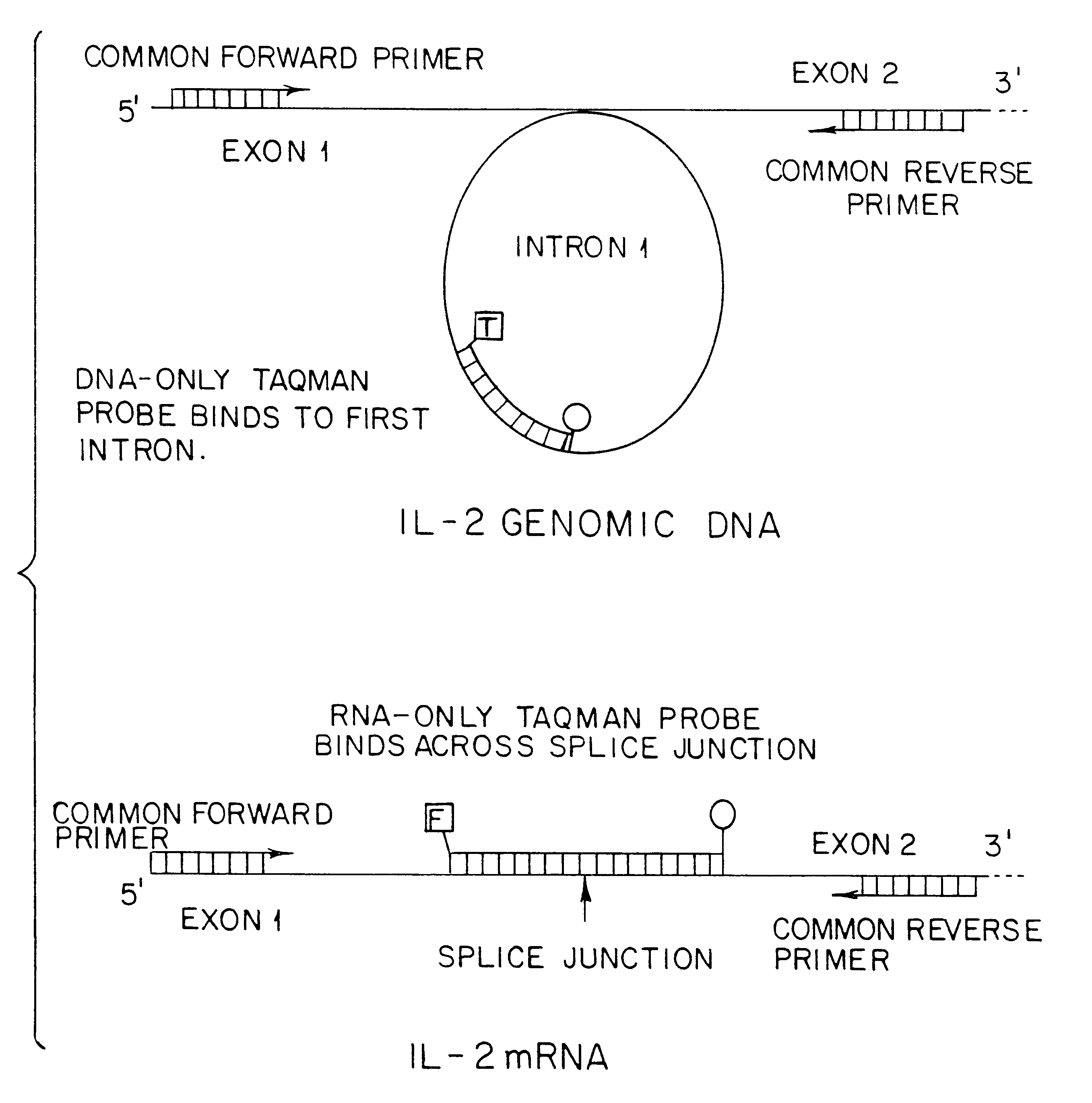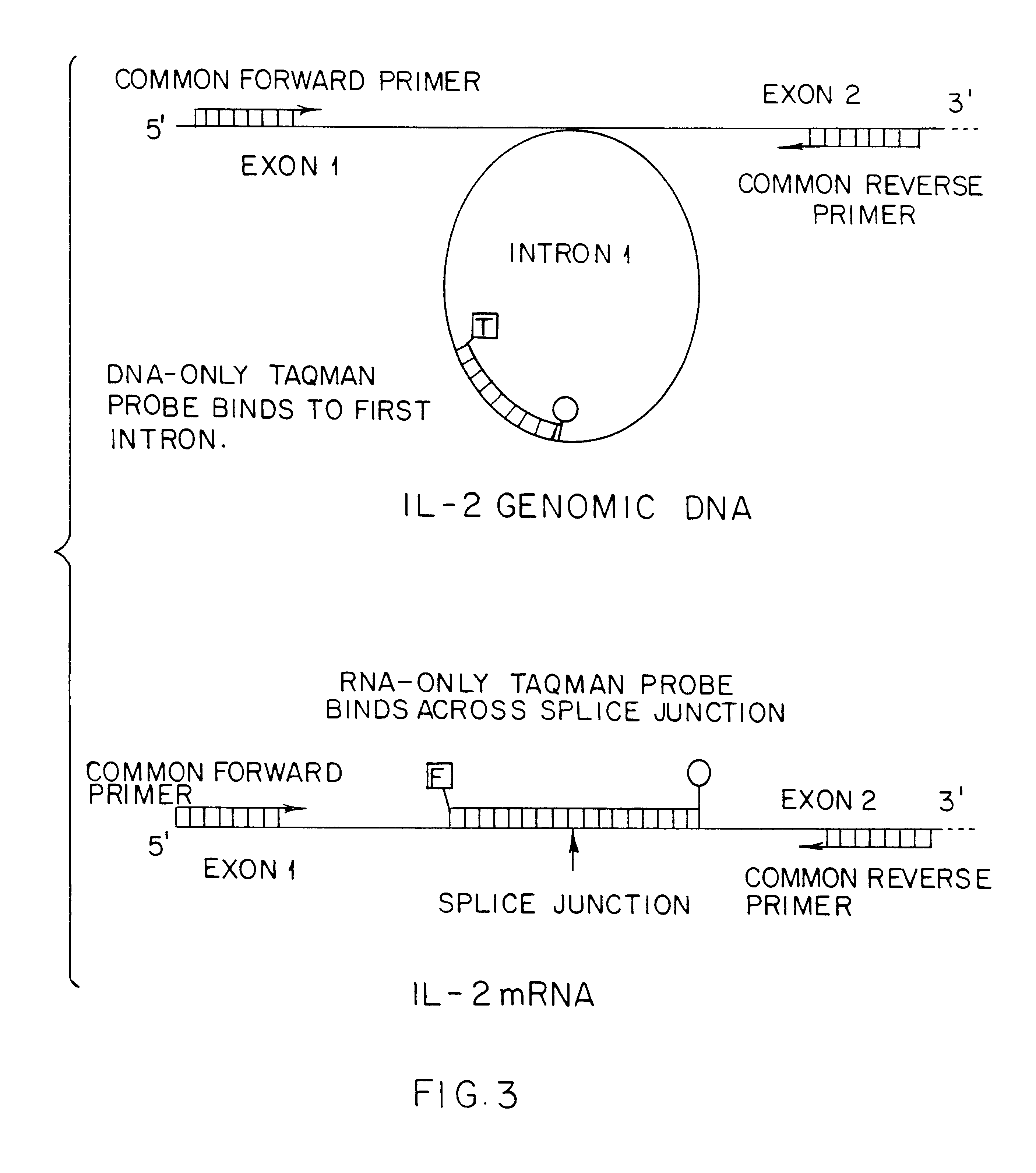Quantitation of RNA transcripts using genomic DNA as the internal amplification competitor
a technology of genomic dna and quantitative analysis, applied in the field of nucleic acid probe technology, can solve the problems of lack of sensitivity, difficult absolute quantitation of sample copy number, and inability to use nucleic acid probe tests based on hybridization for quantitative analysis
- Summary
- Abstract
- Description
- Claims
- Application Information
AI Technical Summary
Benefits of technology
Problems solved by technology
Method used
Image
Examples
example 2
Isolation of Nucleic Acid
A commercial rapid preparation, "QIAamp HCV",is utilized for the isolation and extraction of total nucleic acid per the manufacturer's instructions (Qiagen Inc., Chatsworth, Calif.). The method disclosed herein is compatible with any nucleic acid extraction methodology, wherein both DNA and RNA are purified.
example 3
Confirmation of Probe Specificity
The first set of experiments performed with the components of this assay were designed to confirm the lack of cross-talk between the DNA and RNA "TaqMan.RTM." probes using RAJI cell DNA and RNA and the GAPDH gene probes. The results of these experiments confirm a lack of cross-talk, but only after retreating the pure RNA preparation with preparations from DNA contamination or vice versa. Simplex PCR (only one "TaqMan.RTM." probe in a reaction) using purified DNA and RNA shows signal generation using RAJI cell DNA and RNA, respectively. Also, cross-talk is observed between the GAPDH gene DNA probe and the RAJI cell RNA preparation; cross-talk is not observed between the RNA probe and the RAJI cell DNA preparation. Further treatment of the RNA preparation with additional DNases eliminates this cross-talk. Similar experiments with the IL-2 "TaqMan.RTM." probes give similar results, not shown here.
example 4
GAPDH Constitutive Transcription / IL-2 Induction
Jurkat cells, American Type Culture Collection No. T1B-152 clone E6-1 (ATCC E6-1), are grown to the desired cell density and split up into 1.0 ml cultures. Mitogen is added to these in 0.times., 1.times., 5.times. and 10.times. concentrations and the cultures returned to the incubator and harvested at the following times: 2 hours, 4 hours, 8 hours, 24 hours, 48 hours and 72 hours subsequent to mitogen addition. The total nucleic acid is extracted and purified using "QIAamp" columns and stored frozen, at -20.degree. C. (Qiagen Inc., Chatsworth, Calif.). "TaqMan.RTM." PCR with nucleic acid preparations from Jurkat cells give signal for both the DNA and RNA GAPDH, and the IL-2 DNA probes.
IL-2 induction is performed using Jurkat cells grown to a density of 2.times.10.sup.6 cells per milliliter with phytohemagglutinin and phorbol myristate acetate as mitogens (1.0 .mu.g / ul and 50 .mu.g / ul, respectively). The cells are harvested at various ti...
PUM
| Property | Measurement | Unit |
|---|---|---|
| density | aaaaa | aaaaa |
| density | aaaaa | aaaaa |
| concentration | aaaaa | aaaaa |
Abstract
Description
Claims
Application Information
 Login to View More
Login to View More - Generate Ideas
- Intellectual Property
- Life Sciences
- Materials
- Tech Scout
- Unparalleled Data Quality
- Higher Quality Content
- 60% Fewer Hallucinations
Browse by: Latest US Patents, China's latest patents, Technical Efficacy Thesaurus, Application Domain, Technology Topic, Popular Technical Reports.
© 2025 PatSnap. All rights reserved.Legal|Privacy policy|Modern Slavery Act Transparency Statement|Sitemap|About US| Contact US: help@patsnap.com



